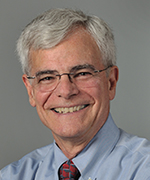From the Deputy Director for Intramural Research
Taking Stock of the NIH Research Festival
Don’t Miss the Very Best that NIH Has to Offer

The 2017 NIH Intramural Research Festival, co-chaired by scientific directors Susan Amara (NIMH) and Steve Chanock (NCI’s Division of Cancer Epidemiology and Genetics), was by most accounts an amazing scientific potpourri of innovative research and new biotechnology as well as an opportunity to showcase the work of our trainees and fellows in the context of the long-term goals for intramural research.
Yet attendance was at best modest for most of the sessions. What can or should we do to encourage all of our scientific staff to participate more fully in the Research Festival?
Let’s take a step back to review the purpose and history of the festival. It had its beginnings in 1986 when then–Scientific Director Abner Notkins (NIDCR) dreamed up the idea for the first NIH Intramural Research Day. His stated goal was to bring our scientific staff out of their laboratories and clinics to meet each other in an informal setting to share research and receive constructive feedback and to enhance opportunities for collaboration. There were anecdotes at the time that NIH intramural scientists were meeting for the first time at national and international scientific meetings. So Research Day was intended as a way to get NIH scientists to meet each other on campus.
The Research Festival has evolved into a multiday event. We have added a mix of plenary sessions focusing on themes developed by the scientific directors who lead each year’s festival program committee, and workshops reflecting the interests of our scientific interest groups. (Every year two different scientific directors with complementary interests are asked to manage the festival.) Plenary-session themes this year included the BRAIN Initiative, inflammatory diseases, and the Cancer Moonshot.
Other popular events included the Technical Sales Association tent show of scientific equipment and services and poster sessions featuring posters from our postdoctoral fellows (including winners of the Fellows Award for Research Excellence), NIH leadership, and “future leaders” who are being recruited for positions at the NIH. And there was more: special exhibits on resources for intramural research; a Green Labs Fair featuring the latest in “green” tools and techniques; virtual-reality demonstrations; and an animal-tribute ceremony acknowledging the important role animals play in research. Since a “festival” should be festive, we had food provided by local vendors and refreshments at the workshops and poster sessions. One year we even had a “battle of the bands” featuring NIH directors.
For scientists who argue convincingly and consistently that research conferences are an essential element of their discipline, why don’t more of us attend our Research Festival? In a survey we conducted several years ago, we found that the major reason given by our fellows for not attending NIH lectures and scientific events, such as the Research Festival and the NIH Director’s Wednesday Afternoon Lecture Series, was conflicting activities (the research itself, deadlines involving publication and other administrative requirements, and other events, of which there are many at the NIH). So in setting priorities, NIH communal research activities, most of which are not spot-on focused on the lab or clinical work of the scientist, get less attention.
Why is not giving the Research Festival a higher priority a strategic mistake? Most of the truly paradigm-shifting science in modern biology has come from interactions among people in multiple different fields. Given the rich intellectual environment at the NIH, with over 1,000 principal investigators and nearly 3,000 postdoctoral fellows, we are in a prime position to generate truly exciting collaborations just within the NIH. This is precisely the same reason for the Wednesday Afternoon Lectures, which are designed to stimulate trans-disciplinary approaches across the more thematic lines of institutes and centers (ICs). We have tried to encourage collaborations in many ways including providing funding for trans-NIH collaborations through the new Innovation Awards program, through the established Bench-to-Bedside program, through IC-based grants for this purpose, and via shared resources and shared core facilities. Our newly renovated IRP website communicates the excitement and the diversity of NIH science, and the NIH Intramural Database allows anyone to find a colleague with a resource or interest that would lead to fruitful collaboration.
But nothing replaces the one-on-one interactions and conversations that occur at the Research Festival, and the chance for anyone who attends to be guided through what is most exciting currently in NIH intramural research even if it does not coincide with their current research program.
We have set the dates for next year’s Research Festival (September 12–14, 2018) and want to encourage all of you to participate more fully. We will remind you through the year about the event in hopes that you will not schedule other activities during this time. I will continue to remind you, in forums such as this, how important it is for career development and enhancement to think outside the box. And we will ensure that the NIH Research Festival continues to highlight our best and most exciting science.
If you tend to pass on such events, you may be missing the very best of what NIH has to offer—a chance to learn new things from experts within our midst. We craft the Research Festival to highlight scientific trends and to provide you with insight into where the IRP is heading and who is doing what.
As always, I welcome your ideas.
This page was last updated on Friday, April 8, 2022
